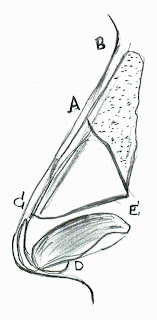1561-1570
------------------------------
Updated: July 2, 2023
1561) Which of the following statements regarding the SUBDOMAL graft in rhinoplasty is FALSE?
A. It is a bar-shaped graft placed in a pocket under the domes.
B. It is indicated for correction of dome asymmetry.
B. It is indicated for correction of dome asymmetry.
C. It is indicated for improving tip projection.
D. It is indicated for correction of a pinched nose tip deformity.
E. The nasal septal cartilage is the preferred grafting material
A. Carbon Dioxide laser
1563) Which of the following is the critical component in the successful open rhinoplasty?
1565) Which of the following in Dorsal Preservation Rhinoplasty (DPR) is FALSE?
A. DPR avoids lateral crural resection.
E. The nasal septal cartilage is the preferred grafting material
1562) Which of the following modalities of non-surgical treatment for male pattern hair loss is approved by the Food and Drug Administration?
A. Carbon Dioxide laser
B. Erbium:YAG laser
C. Low-level laser light therapy
D. Platelet-Rich Plasma injections
E. Spirolactone topical use
1563) Which of the following is the critical component in the successful open rhinoplasty?
A) Cottle incision to nasal septum
B) Killian incision to nasal septum
C) Anterior septal angle approach
D) Full transfixion incision
E.) Hemi transfixion incision
1564) Which of the following complications is the most common seen in Dorsal Preservation Rhinoplasty (DPR)?
E.) Hemi transfixion incision
1564) Which of the following complications is the most common seen in Dorsal Preservation Rhinoplasty (DPR)?
A. Persistence of the dorsal hump.
B. Polly beak deformity.
B. Polly beak deformity.
C. Open roof deformity.
D. Nasal valve stenosis.
E. External nasal valve collapse.
D. Nasal valve stenosis.
E. External nasal valve collapse.
1565) Which of the following in Dorsal Preservation Rhinoplasty (DPR) is FALSE?
A. DPR avoids lateral crural resection.
B. DPR uses a subperichondrial dissection plane.
C. DPR utilizes a bloc lowering of the nasal dorsum
D. DPR is best if used in V-shaped nasal bone
D. DPR is best if used in V-shaped nasal bone
1556) Which of the following area is considered the "keystone area" in rhinoplasty analysis"
A. A
B. B
C. C
C. C
D. D
E. E
A. 2 weeks
ANSWERS & REFERENCES
1561) C It is indicated for improving tip projection.
1556) A A
1567) A Alopecia
1569) C Hyperglycemia
1570) B Bossae/Maintain at least 4 mm of lower lateral cartilage during cephalic trimming.
.
1567) Which of the following is the MOST common complication seen in the use of the Temporal Parietal Fascia Flap (TPFF)?
1567) Which of the following is the MOST common complication seen in the use of the Temporal Parietal Fascia Flap (TPFF)?
A. Alopecia
B. Necrosis
B. Necrosis
C. Weakness of the frontalis muscle
D. Venous congestion
E. Hematoma
E. Hematoma
1568) Which is the proper timing to initiate radiation therapy following ontological surgery without significantly impending wound healing?
A. 2 weeks
B. 3 weeks
C. 6 weeks
D. 8 weeks
E. 10 weeks
1569) Which of the following is NOT considered a long-term complication/cell damage after the course of radiotherapy?
A. Necrosis
B. Atrophy
C. Hyperglycemia
D. Fibrosis
D. Fibrosis
E. Carcinogenesis
1570) Which of the following statements regarding preventative measures against rhinoplasty complications is FALSE?
A. Septal hematoma/Quilting sutures
B. Bossae/Maintain at least 4 mm of lower lateral cartilage during cephalic trimming.
C. Rocker deformity/Avoid osteotomies to far into the frontal bones.
C. Rocker deformity/Avoid osteotomies to far into the frontal bones.
D. Inverted V deformity/autospreader graft placement.
E) Pollybeak deformity/adequate take-down of cartilaginous dorsal septum with removal of the anterior septal angle.
ANSWERS & REFERENCES
1561) C It is indicated for improving tip projection.
Karimnejad K., Walen S.: Functional and Cosmetic Eyelid Surgery, Complications in Eyelid Surgery, Facial Plastic Surgery Clinic N. America, 24 , May 2016, pp. 193-203
1562) C Low-level laser light therapy
1562) C Low-level laser light therapy
Tai Tymon, Kochhar A.: Physiology and Medical Treatment for Alopecia, Techniques for Hair Restoration, Facial Plastic Surgery Clinic N. America, 28 (2020), pp. 149-159
Justicz N., Derakhshan A., Chen J. X., Lee L. N.: Platelet-Rich Plasma for Hair Restoration, Techniques for Hair Restoration, Facial Plastic Surgery Clinic N. America, 28 (2020), pp. 181-187
1563) C Anterior septal angle approach
Rohrich R.J., Dauwe P. B., Pulikkottil B.J., Pezeshk R.A.: The Importance of the Anterior Septal Angle in the Open Dorsal Approach to Rhinoplasty, Special Topic, Plastic and Reconstructive Surgery. 2017; 139 (3): 604-612
1564) A Persistence of the dorsal hump.
Saman M., Saban Y.: Long-Term Follow-up with Dorsal Preservation Rhinoplasty, Facial Plastic Surg. Clin. North America 31 (2023) pp.13-24
1565) E. DPR requires the use of spreader grafts.
Patel P. N., Most S. P., Saban Y.: Overview of Dorsal Preservation Rhinoplasty, Facial Plastic Surg. Clin. North America 31 (2023) pp.1-11
1556) A A
Saman M., Saban Y.: Long-Term Follow-up with Dorsal Preservation Rhinoplasty, Facial Plastic Surg. Clin. North America 31 (2023) pp.13-24
Revenaugh P.C., Shipchandler T. Z., Burkey B.B.: Microvascular and Regional Flaps in Head and Neck Reconstruction, chapter 51 in (Papel I. editor), Thieme, Fourth Edition, 2016, pp. 650-677
1568) B 3 weeks
Hom D. B., Davis M. E.: Reducing Risks for Poor Surgical Wound Healing in Facial Plastic Surgery Clinic N. America, 31 (2023), pp. 171-181
Hom D. B., Davis M. E.: Reducing Risks for Poor Surgical Wound Healing in Facial Plastic Surgery Clinic N. America, 31 (2023), pp. 171-181
Watson D., Crawford K. L.: Reducing Surgical Risks in the Rhinoplasty Patient, Clinic N. America, 31 (2023), pp. 209-220
-------------------------------
Updated: July 2, 2023

No comments:
Post a Comment